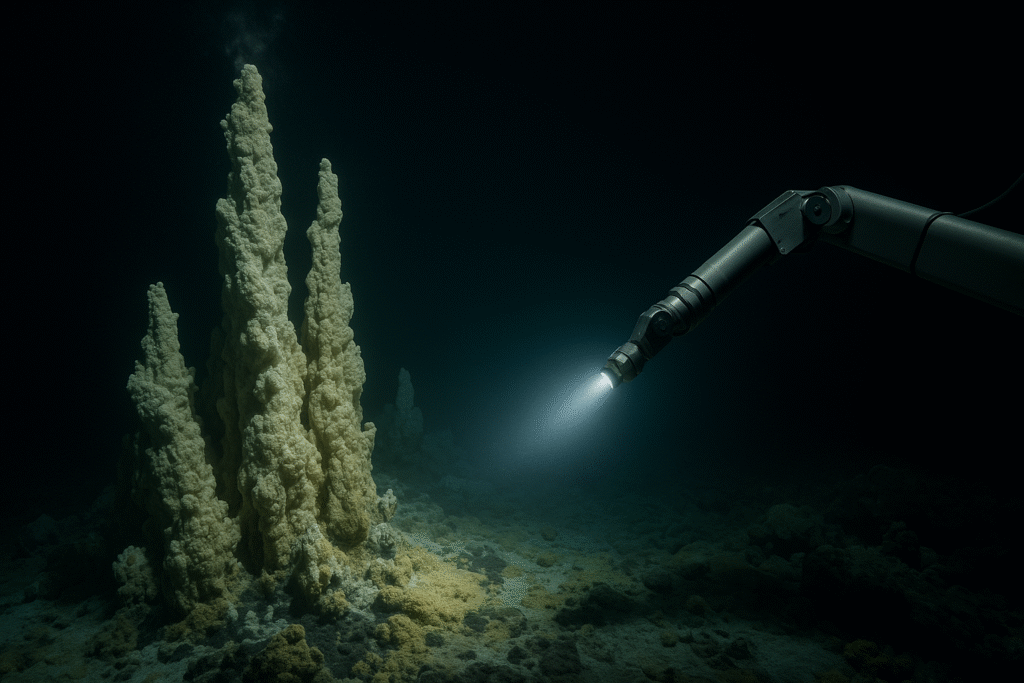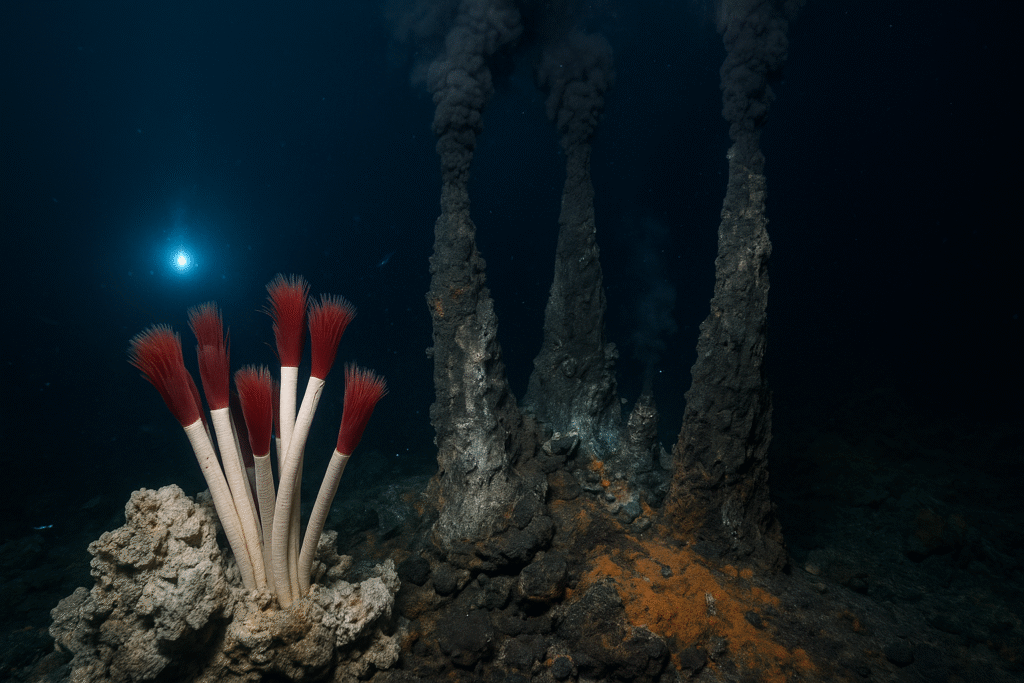Hydrothermal vents are seafloor hot springs where seawater circulates through oceanic crust, heats to ~750 °F (400 °C), dissolves metals and gases, and gushes back into the deep ocean. They occur mainly along mid-ocean ridges and back-arc basins, forming chimney “smokers” and fueling unique ecosystems powered by chemosynthesis.
How Hydrothermal Vents Work
Hydrothermal vents form where the seafloor is volcanically active. Cold seawater seeps into fractures, warms as it passes near magma, reacts with rock, and becomes acidic, metal-laden fluid. Under the crushing pressure of the deep sea, this hot fluid does not boil; instead, it rises and erupts from openings in the seabed, building chimneys of metal sulfides and carbonates. Typical vent depths are 8,200–13,100 ft (2,500–4,000 m), where temperatures can approach ~750 °F (400 °C) at the orifice. NOAA offers a clear primer on this circulation.
Most vents sit on the world-spanning mid-ocean ridge system—about 40,390 miles (65,000 kilometers) long—where tectonic plates spread and new crust forms. They also occur in back-arc basins and some hotspot settings. The ridge network is Earth’s longest mountain chain, almost entirely underwater, and it focuses much of the planet’s volcanism and hydrothermal flow.

Black Smokers vs. White Smokers
“Black smokers” are the hottest vents, typically ~660–752 °F (350–400 °C). Their dark plumes are tiny particles of metal sulfides (iron, copper, zinc) that precipitate as hot fluid hits cold seawater. “White smokers” are cooler, roughly 212–572 °F (100–300 °C), dominated by barium, calcium, and silica; their plumes look pale or milky. Both types often cluster along fissures, forming forests of tall chimneys that may grow, collapse, and rebuild within years.
Alkaline Vents (Lost City–Type)
In contrast, “alkaline” vents like the Lost City Hydrothermal Field on the Atlantis Massif are cooler—about 104–194 °F (40–90 °C)—and highly basic (pH ~9–11). They arise when seawater reacts with ultramafic rocks (serpentinization), generating hydrogen and methane and building pale carbonate towers tens of meters high. These conditions are central to leading hypotheses about life’s origins. Seminal field studies of Lost City and NASA astrobiology summaries explain the chemistry and astrobiological relevance.
| Vent Type | Typical Temperature | pH | Common Depth | Dominant Chemistry | Example Field |
|---|---|---|---|---|---|
| Black smoker | ~750 °F (400 °C) | ~2–3 (acidic) | 8,200–13,100 ft (2,500–4,000 m) | Fe, Cu, Zn sulfides; H2S | East Pacific Rise (21°N) |
| White smoker | ~212–572 °F (100–300 °C) | ~3–5 | Similar to above | Ba/Ca sulfates; silica | Endeavour Segment (NE Pacific) |
| Alkaline vent | ~104–194 °F (40–90 °C) | ~9–11 (basic) | ~2,600 ft (800 m) | H2, CH4; carbonate chimneys | Lost City (Mid-Atlantic) |
Life Without Sunlight — Chemosynthesis & Deep-Sea Ecosystems
Unlike surface ecosystems powered by sunlight, vent communities run on chemical energy. Microbes oxidize hydrogen sulfide and hydrogen, fixing carbon dioxide into organic matter — a process called chemosynthesis. In simplified form: CO2 + 4 H2S + O2 → CH2O + 4 S + 3 H2O. These microbes form mats on chimneys and live inside animals, providing the base of a dense food web of shrimp, crabs, snails, clams, and fish.
Many species are endemic—found nowhere else—and evolve rapidly as vents open, change, and die. Colonies can rebound after eruptions, but the habitats are patchy and short-lived on human timescales. Conservation discussions increasingly consider these fragile oases, especially as interest grows in seafloor resources.
Giant Tube Worms & Symbiosis
The iconic giant tube worm Riftia pachyptila can exceed 10 ft (3 m) and lacks a mouth and gut. Instead, it hosts sulfur-oxidizing bacteria in a special organ (the trophosome). The microbes feed the worm; the worm supplies chemicals and oxygen via blood rich in hemoglobin adapted for sulfide-laden water.
Crabs, Shrimp, and Microbes
Other creatures, such as yeti crabs and vent shrimp, graze microbial mats or farm microbes on their bristles. Bacterial films also coat the inner walls of chimneys, mediating mineral deposition and energy flow. For approachable overviews, see the Smithsonian’s explainer on vent microbes.
Where Vents Occur — Global Distribution & Notable Fields
Hydrothermal vents track plate boundaries. The mid-ocean ridge system—about 40,390 miles (65,000 kilometers) long—hosts countless vent fields, and more occur in back-arc basins of the Pacific. A landmark find came in 1977 at the Galápagos Rift, when the submersible Alvin encountered thriving vent communities and “smokers,” changing biology textbooks overnight. Subsequent dives at the East Pacific Rise (1979) revealed classic black smokers.
Cataloging these sites is ongoing. The InterRidge Global Database (Version 3.4, 2020) listed 721 vent fields worldwide, with 666 confirmed or inferred active—numbers that continue to update as expeditions map the seafloor. For researchers and policymakers, the InterRidge database remains the authoritative registry of known active submarine vents.
Why Hydrothermal Vents Matter
Vents are engines of ocean chemistry. They inject metals (iron, manganese, copper, zinc) and reduced gases (H2, H2S, CH4) into deep waters, feed microbial life, and influence nutrient cycles far from their source. On geological timescales, hydrothermal circulation helps cool the oceanic crust and alters rocks to new minerals (e.g., serpentinite), connecting the hydrosphere to Earth’s mantle.
They also inform debates about life’s origins. Alkaline vents create natural chemical gradients and catalytic mineral surfaces—features that laboratory and field studies argue could have powered the first metabolic pathways. Beyond Earth, spacecraft data suggest hydrothermal activity in the subsurface oceans of Enceladus and possibly Europa, making vents prime targets in the search for life. See NASA’s discussions of silica “nanograins” and hydrogen detected by Cassini in Enceladus’ plumes.
Minerals & Resources
Vent chimneys concentrate metal sulfides and carbonates, forming deposits rich in copper, zinc, and precious metals. While commercial deep-sea mining remains controversial, vents are natural laboratories for how such ores form. Any resource discussions must balance economic interest with the ecological uniqueness and vulnerability of vent ecosystems.
Origins of Life & Astrobiology
Alkaline vent chemistry—hydrogen production via serpentinization, high pH, and porous catalytic walls—has inspired “ocean world” mission concepts. NASA’s astrobiology program frames vents as analogs for habitats on icy moons. Readers can explore NASA’s Cassini Enceladus science pages for the latest mission-based evidence.
How We Explore Vents
Scientists reach vents using human-occupied vehicles (HOVs) like DSV Alvin, remotely operated vehicles (ROVs), and autonomous underwater vehicles (AUVs). High-resolution sonar mapping and seafloor observatories reveal new fields and track changes in temperature, chemistry, and biology over time. Expedition logs from WHOI’s vent program provide accessible summaries of these tools and findings.
Vent landscapes are dynamic. Eruptions can seal old chimneys and open new ones, shifting habitats within months to years. This ephemerality complicates long-term monitoring but also offers a natural laboratory for observing ecosystem succession, mineral growth, and crustal cooling in real time.
FAQ
Where are most hydrothermal vents found?
Along the mid-ocean ridge system—the longest mountain chain on Earth at about 40,390 miles (65,000 kilometers)—and in some back-arc basins.
How hot are black smokers?
Typically ~750 °F (400 °C) at the vent mouth, hot enough to precipitate metal sulfides instantly when mixed with cold seawater.
When were hydrothermal vents discovered?
The first confirmed communities and smokers were documented in 1977 near the Galápagos Rift by the submersible Alvin, followed by black smoker fields at the East Pacific Rise in 1979.
Do vent ecosystems rely on sunlight?
No. They run on chemosynthesis—microbes use chemical energy from hydrogen sulfide or hydrogen to build organic matter, supporting larger animals.
What Did We Learn Today?
- Hydrothermal vents are deep-sea hot springs that can reach ~750 °F (400 °C) and occur mainly along spreading ridges.
- Chemosynthetic microbes power entire ecosystems, including giant tube worms up to 10 ft (3 m) long.
- Vent types include black smokers, white smokers, and alkaline systems like Lost City with pH ~9–11.
- The ridge network spans ~40,390 miles (65,000 kilometers), hosting hundreds of known vent fields.
- Vents matter for metals, ocean chemistry, and hypotheses about life’s origins on Earth and icy moons.
Contextual resources: NOAA: What is a hydrothermal vent? · WHOI: Hydrothermal vents overview · NASA: Cassini & Enceladus hydrothermal evidence





